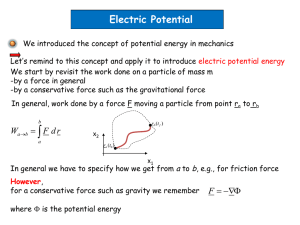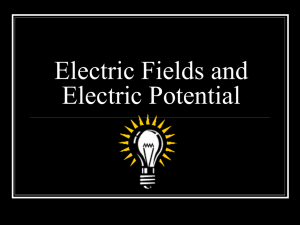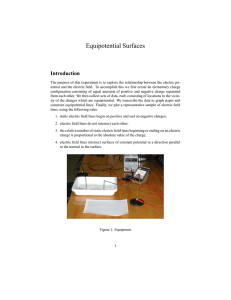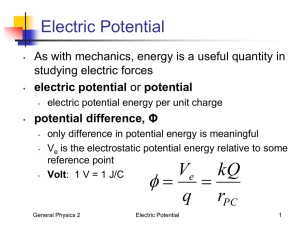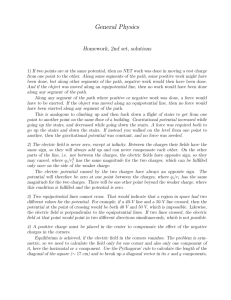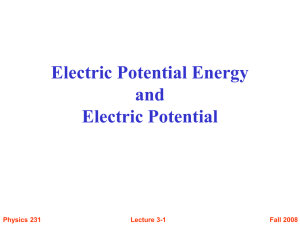Chapter 23 Electric Potential
advertisement
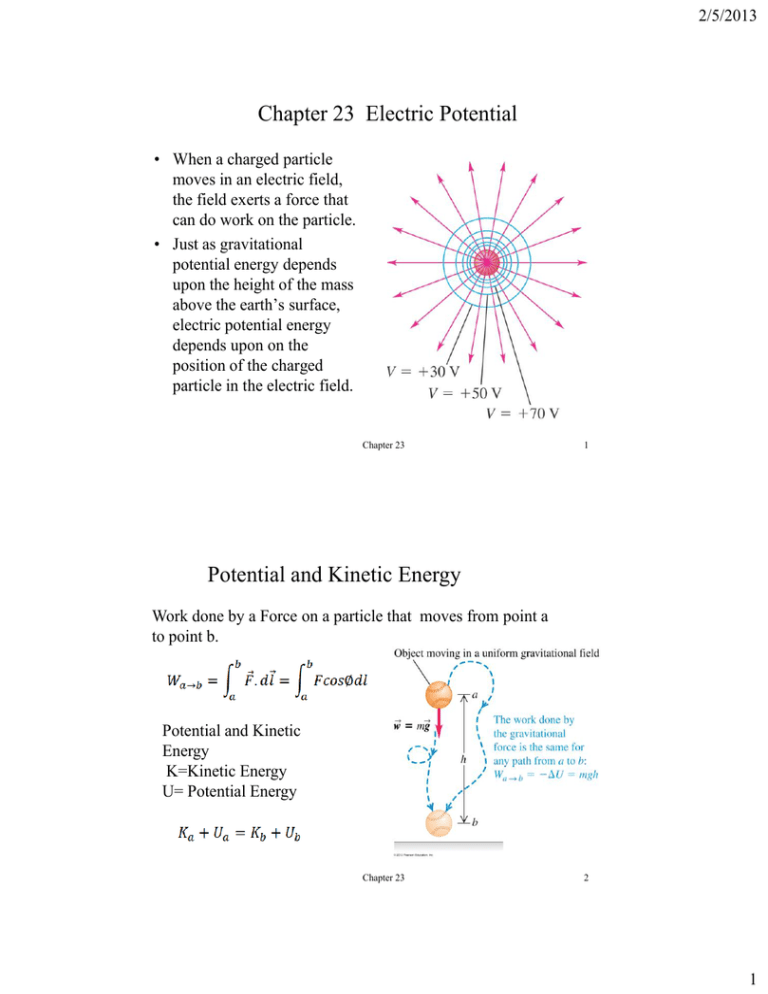
2/5/2013 Chapter 23 Electric Potential • When a charged particle moves in an electric field, the field exerts a force that can do work on the particle. • Just as gravitational potential energy depends upon the height of the mass above the earth’s surface, electric potential energy depends upon on the position of the charged particle in the electric field. Chapter 23 1 Potential and Kinetic Energy Work done by a Force on a particle that moves from point a to point b. Potential and Kinetic Energy K=Kinetic Energy U= Potential Energy Chapter 23 2 1 2/5/2013 Electric Potential Energy (joules) Electric Potential Energy in a Uniform Electric Field b b Wa b F dl F cos dl a a F q0 E Wab Fd q0 Ed (Uniform electric field) where Ua is the potential energy at point a and Ub is the potential energy at point b. Chapter 23 3 An electric charge moving in an electric field U decreases U increases U decreases U increases 2 2/5/2013 Electric Potential Energy Electric potential energy distance r away from a point charge rb rb rb ra ra Wa b Fr dr Fr cos dr Fr dr ra qq0 qq0 1 1 (23-8) dr 2 4 0 r 4 0 ra rb ra rb rb 1 Wab Fr dr ra Wab qq0 1 qq0 1 U a Ub 4 0 ra 4 0 rb joules where Ua = potential energy at point a and Ub = potential energy at point b Wa As rb qq0 1 U a = Potential energy of q0 4 0 ra between point a and Figure 23-5 infinity. where U is the potential energy of q0 at any distance r away from a point charge q. Chapter 23 5 Work out the Integration qq0 qq0 1 1 dr 2 4 0 r 4 0 ra rb ra rb rb 1 Wab Fr dr ra rb 4 ra 1 qq0 0 r2 qq0 r 1 4 0 1 n Wab dr rb ra u n 1 u du n 1 Recall qq0 4 0 rb ra r dr r2 b qq0 r 1 4 0 1 ra qq0 1 1 qq0 1 1 4 0 rb ra 4 0 ra rb qq0 1 qq0 1 U a Ub 4 0 ra 4 0 rb Chapter 23 6 3 2/5/2013 Electric Potential Energy is path independent Figure 23-5 cos dl dr rb rb rb Wa b Fr dl Fr cos dl Fr dr ra ra ra Chapter 23 7 Potential energy curves—PE versus r • Graphically, the potential energy between like charges increases sharply to positive (repulsive) values as the charges become close. • Unlike charges have potential energy becoming sharply negative as they become close (attractive). • Refer to Example 23.1. 4 2/5/2013 Electric Potential Energy Electric potential energy distance r away from many point charges The total potential energy is the algebraic sum of the individual charge energy Ua q0 q1 qq qq q0 0 2 0 3 4 0 r1 4 0 r2 4 0 r3 4 0 q1 q2 q3 r2 r3 r1 Chapter 23 9 Chapter 23 10 5 2/5/2013 Solution Chapter 23 11 Electrical Potential • Electric field is force per unit charge • Flowing from potential energy U on q0 • Electric potential is potential energy per unit charge U/q0 • Electric potential is also known as “Potential” units volt • V = U/q0 Chapter 23 12 6 2/5/2013 Battery a source of electrical potential • The potential of a battery can be measured between point a and point b (the positive and negative terminals). • Moving with the electrical field decreases the electrical potential. Electric Potential (Voltage) = Potential Energy per unit charge Wab a b F Definition Vab E · · q0 +q 0 1 volt = 1 joule/coulomb = J/C Vab Va Wab U a U b U a U b Va Vb q0 q0 q0 q0 Ua q0 Vb volts b Ub q0 Wab q0Vab volts Note: 1 ev = (1.6 x 10-19) joules b Wab F dl q0 E dl a Vab W 1 ab q0 q0 a b b q0 E dl E dl a a Chapter 23 joules 14 7 2/5/2013 Electric Potential (Voltage) Electric potential distance r away from a point charge Ua Ua Va 1 F a .r a 4 0 qq0 4 0 ra 1 Ua 1 q q0 4 0 ra qq0 ra 2 ra Ub qq0 4 0 rb 1 Vb Ub 1 q q0 4 0 rb Vab Va Vb Chapter 23 15 Electric Potential (Voltage) Electric potential distance r away from many point charges The total Electric Potential is the algebraic sum of the individual potentials Va Ua q3 q1 q2 1 q0 4 0 r1 4 0 r2 4 0 r3 4 0 Chapter 23 q1 q2 q3 r1 r2 r3 16 8 2/5/2013 Electron-Volts is a Unity of Energy Wab U a Ub qVa Vb qVab q = e = 1.602 x10-19 C For Vab = 1 volt Ua-Ub = 1.602 x10-19 J (energy) 1eV = 1.602 x10-19 J V = Potential difference Chapter 23 Fermi Lab in Illinois Tevatron - record 0.98 TeV eV =energy in joules 17 CERN's Large Hadron Collider (LHC) reached 3.5 TeV per beam in 2010 1TeV= 1x1012 eV Chapter 23 18 9 2/5/2013 LHC running two years at 3.5 TeV April 2012 LHC operates at 8TeV – a world record All in the search of the of the subatomic particle that establishes “mass” (Higgs boson) 2014 14TeV ? Chapter 23 19 Electric Potential (Voltage) Example 23-4 Figure 23-13 Va q1 = q2 = 12 nC Ua q1 q2 900V q0 4 0r1 4 0r2 Vb Ua q1 q2 1930V q0 4 0r1 4 0r2 Vc Va Ua q1 q2 0V q0 4 0r1 4 0r2 q1 q2 1 1 9 x109 x12x109 x( ) 1800 2700 900V 4 0r1 4 0r2 .06 .04 Chapter 23 20 10 2/5/2013 Chapter 23 21 Example 23.4 Continued Chapter 23 22 11 2/5/2013 Movement and Electric Potential difference Ex-23.7 23 A 5.0 ug dust particle with a charge of 2.0nC moves from a to b What is vb ? K a U a Kb U b 0 U a Kb U b Kb U a U b U a q0Va U b q0Vb U a U b q0Va q0Vb q0 (Va Vb ) 1 2 mvb q0 (Va Vb ) q0Vab 2 Kb Solve for vb vb 2q0 (Va Vb ) 46m / s m Calculate Vb and Va Vb Va q1 4 0 r1 q2 4 0 r2 9 x109 x3x10 9 x( 1 1 ) 1350 .01 .02 q1 q2 1 1 9 x109 x3x10 9 x( ) 1350 4 0 r1 4 0 r2 .01 .02 Va Vb 1350 (1350) 2700V See details page 766 Chapter 23 23 A Charged Conducting Sphere – Electric Field and Electric Potential Inside the sphere E = 0 every where Inside the sphere V is the same every where. Outside the field is same as point charge at center. No work is done moving a charge inside the sphere Vsurface EsurfaceR Figure 23-16 Chapter 23 24 12 2/5/2013 Chapter 23 25 Chapter 23 26 13 2/5/2013 The Empire State Building is struck up to 500 times a year…..why? Chapter 23 27 Ionization and Corona Discharge For air to be ionized at the surface of the sphere E > 3 x 10 6 V/m What is V at the surface? At the surface of a charged conducting sphere Vsurface EsurfaceR p.768 Vsurface EsurfaceR q 4 0 R 2 R Vm Em R q 4 0 R Vm Em 3x106V / m R To get more potential energy increase the R. To get discharge (corona) at low voltage reduce, R. R Vm 2m 6MV Application 0.2m (8 in) 600 KV 10 mm 30KV Radio antenna top, lighting rod 1 mm 3 KV Corona wire – (laser printer) Scientific experiments Classroom Van de Graaff Generator Chapter 23 28 14 2/5/2013 Lightening Thunder is formed from the shock wave formed by the rapid heating of the air along the path of the return stroke, which reaches some 30,000 degrees K. The sound of thunder varies depending on how far you are from the various parts of the stroke. The sound from a part of the stroke farther away will get to you later and be fainter. 29 Chapter 23 Electric Potential Oppositely Charged Parallel Plates Find the electric potential V due to charged plates b b a a Vab E dl E cos dl Ed From section 22.4 0 0E 0Vab / d E coul/m2 charge Vab = Ed Uniform Electric Field Chapter 23 A way of measuring charge density coul/m2 charge 30 15 2/5/2013 Difference in Potential between two points outside an Infinite Line Charge or Charged Conducting Cylinder. Example 23-10 From section 22.6 The electric field from a long wire had only a radial component b Er a 1 2 0 r Expand the wire to a cylinder and calculate the potential at two points a, b. The charge is on the surface and E=0 inside. b b Vab E dl E cos dl a Vab a rb Er dr ra 2 0 rb ra dr r r ln b 2 0 ra Chapter 23 31 Chapter 23 32 16 2/5/2013 Chapter 23 33 Contour Maps & Equipotential Surfaces Contour lines on a topology map are curves of equal gravitational potential energy By analogy Equipotential surfaces are surfaces where the electric potential is the same Chapter 23 34 17 2/5/2013 Equipotential Surfaces •Field lines are perpendicular to Equipotential surface (lines) •E need not be constant over an Equipotential surface(lines). To the right, Ea is greater than Eb b a b Vab E dl a dl dV Edl dV E As E increases dl must decrease. This means the Equipotential will closer Equipotential surfaces and field lines • Surfaces of equal potential may be drawn any charge or charges and the field lines they create. 18 2/5/2013 Equipotential Surfaces Equipotential Surfaces and Conductors Figure 23-25 E parallel = 0. Therefore, E is perpendicular to the surface. This makes the surface of the conductor an equipotential surface. Chapter 23 37 Potential Gradient a b · · E If cos = 1 ( = 0o) b b b a a a b a b a Vab E dl E cos dl Edl Vab dV dV b dV is the infinitesimal small change in V b dV Edl a a dV Edl E dV dl potential gradient Er Chapter 23 V r potential gradient for radial field 38 19 2/5/2013 The Electrical Potential is useful Technique for finding the Electric Field CALCULATE METHODS E field caused by a charge distribution Add the E fields of point charges E is a vector requiring a separate a computation for each component Calculate potential V and taking the gradient Often easier because V is a scalar and is an easier integration Knowing the potential V is a very useful computational technique for finding E Chapter 23 39 Chapter 23 40 20 2/5/2013 Chapter 23 41 Q23.1 When a positive charge moves in the direction of the electric field, A. the field does positive work on it and the potential energy increases. E +q Motion E B. the field does positive work on it and the potential energy decreases. C. the field does negative work on it and the potential energy increases. D. the field does negative work on it and the potential energy decreases. 21 2/5/2013 Q23.2 When a positive charge moves opposite to the direction of the electric field, E Motion A. the field does positive work on it and the potential energy increases. +q E B. the field does positive work on it and the potential energy decreases. C. the field does negative work on it and the potential energy increases. D. the field does negative work on it and the potential energy decreases. Q23.3 When a negative charge moves in the direction of the electric field, A. the field does positive work on it and the potential energy increases. E –q Motion E B. the field does positive work on it and the potential energy decreases. C. the field does negative work on it and the potential energy increases. D. the field does negative work on it and the potential energy decreases. 22 2/5/2013 Q23.4 E When a negative charge moves opposite to the direction of the electric field, Motion A. the field does positive work on it and the potential energy increases. –q E B. the field does positive work on it and the potential energy decreases. C. the field does negative work on it and the potential energy increases. D. the field does negative work on it and the potential energy decreases. Q23.5 The electric potential energy of two point charges approaches zero as the two point charges move farther away from each other. If the three point charges shown here lie at the vertices of an equilateral triangle, the electric potential energy of the system of three charges is Charge #2 +q Charge #1 +q y x –q Charge #3 A. positive. B. negative. C. zero. D. not enough information given to decide 23 2/5/2013 Q23.6 The electric potential energy of two point charges approaches zero as the two point charges move farther away from each other. If the three point charges shown here lie at the vertices of an equilateral triangle, the electric potential energy of the system of three charges is Charge #2 –q Charge #1 +q y x –q Charge #3 A. positive. B. negative. C. zero. D. not enough information given to decide Q23.7 The electric potential due to a point charge approaches zero as you move farther away from the charge. If the three point charges shown here lie at the vertices of an equilateral triangle, the electric potential at the center of the triangle is Charge #2 +q Charge #1 +q y x –q Charge #3 A. positive. B. negative. C. zero. D. not enough information given to decide 24 2/5/2013 Q23.8 The electric potential due to a point charge approaches zero as you move farther away from the charge. If the three point charges shown here lie at the vertices of an equilateral triangle, the electric potential at the center of the triangle is Charge #2 –q Charge #1 +q y x –q Charge #3 A. positive. B. negative. C. zero. D. not enough information given to decide Q23.9 Consider a point P in space where the electric potential is zero. Which statement is correct? A. A point charge placed at P would feel no electric force. B. The electric field at points around P is directed toward P. C. The electric field at points around P is directed away from P. D. none of the above E. not enough information given to decide 25 2/5/2013 Q23.10 Where an electric field line crosses an equipotential surface, the angle between the field line and the equipotential is A. zero. B. between zero and 90°. C. 90°. D. not enough information given to decide Q23.11 The direction of the electric potential gradient at a certain point A. is the same as the direction of the electric field at that point. B. is opposite to the direction of the electric field at that point. C. is perpendicular to the direction of the electric field at that point. D. not enough information given to decide 26
